ABSTRACT
The area between the Asco and Golo valleys in Central Corsica, France (latitudes 42°47′95″N to 42°37′96″N, longitudes from 9°11′82″E to 9°20′72″E) is a key-sector to investigate the stratigraphic and tectonic setting of Alpine Corsica. This sector includes (from the structurally lowest to the highest) the Hercynian Corsica, that represents the European continental margin not deeply involved in the convergence processes, and a stack of oceanic and continental units belonging to the Alpine Corsica, i.e. the domain strongly affected by the Alpine deformation and metamorphism in the Late Cretaceous-Paleogene. The 1:15,000 scale geological map illustrates the tectonic features of Alpine Corsica stack with a special focus to the Lower Units, the units derived from the European thinned continental margin involved in the Alpine convergence.
1. Introduction
The northeastern part of the Corsica Island, France (France, (a)) is characterized by a set of tectonic units consisting of deformed and metamorphic rocks known as Alpine Corsica (AC). This domain is regarded as the southern continuation of the Western Alps and includes a stack of oceanic and continental units originated during the Late Cretaceous-Paleogene closure of the Ligure-Piemontese oceanic basin and the subsequent collision between European and Adria continental margins (e.g. CitationBortolotti et al., 2001; CitationMarroni et al., 2017). AC separated firstly from the European margin by the Late Oligocene-Early Miocene opening and spreading of the Liguro-Provençal Basin and then from the Northern Apennine belt by the Neogene development of the Tyrrhenian Basin (e.g. CitationSperanza et al., 2002). Based on lithostratigraphic and structural features, AC is divided into three groups referred, from the structurally lowest to the highest (), as the Lower Units (LU), the Schistes Lustrés Complex (SL) and the Upper Units (UU). LU consists of a stack of strongly deformed units metamorphosed under blueschist facies conditions derived from the thinned portion of the European continental margin affected by Paleogene convergent tectonics (CitationDi Rosa et al., 2017a; CitationGarfagnoli et al., 2009: CitationMalasoma & Marroni, 2007; CitationMalavieille et al., 1998; CitationMolli, 2008; CitationMolli et al., 2017). SL mostly overlays LU, even if the former has been locally found as slices within LU (CitationDi Rosa et al., 2017b). The SL includes several units affected by pervasive metamorphism ranging from blueschist to eclogite facies, that are interpreted as belonging to the Ligure-Piemontese oceanic basin and its ocean-continent transition (CitationGibbons et al., 1986; CitationLevi et al., 2007; CitationVitale Brovarone et al., 2013). UU are instead thrust above the SL and LU and consist of Middle to Upper Jurassic ophiolite sequences and the associated Upper Jurassic to Upper Cretaceous sedimentary covers (CitationDurand-Delga, 1984; CitationMarroni & Pandolfi, 2003; CitationPandolfi et al., 2016) that show a pervasive deformation with a very low-grade metamorphism.
Figure 1. (a) Tectonic sketch of the central Corsica with the location of the studied area. In the figure, the Hercynian Corsica (HC) is represented in lilac. Within the AC, the Lower Units (TU: Tenda Unit; CU: Caporalino Unit; PU: Pedani Units; FPU: Fuata-Pedanu Unit; PMU: Palasca-Multifao Unit; PPU: Piedigriggio-Prato Unit; CAU: Croce d’Arbitro Unit; CPU: Castiglione-Popolasca Unit), the Schistes Lustrés Complex (SL), the Upper Units (Ba: Balagne Units; Bo: Bas-Ostriconi Unit; Pi: Pineto Unit; SLN: Santa Lucia Nappe) are distinguished. Fb: Francardo Basin; (b) Schematic cross-section of the Central Corsica (modified after CitationDi Rosa et al., 2019a).
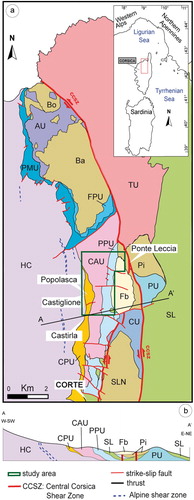
Figure 2. Tectonic sketch of the area and related cross-section. The black box indicates the area of .
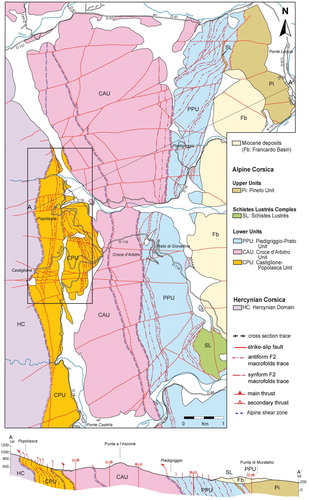
The AC tectonic stack is thrust onto the Hercynian Corsica (HC) domain located in the northwestern part of the Corsica island ((b)). The HC belongs to the inner European continental margin and consists of Permo-Carboniferous magmatic rocks, mainly granitoids, intruded within a Panafrican and Variscan metamorphic basement (CitationRossi et al., 2015 and references therein) and covered by Permian volcanics, Mesozoic carbonates and middle to late Eocene siliciclastic deposits (CitationDurand-Delga, 1984).
The contact between the units of AC and the HC is strongly reworked by the Central Corsica Shear Zone (CCSZ, ), a late Eocene-early Oligocene brittle strike-slip fault system (CitationWaters, 1990) sealed by Burdigalian-Langhian sedimentary deposits such as the Francardo Basins (CitationAlessandri et al., 1977; CitationFerrandini et al., 1998).
This paper describes the stratigraphic and structural features of the LU outcropping in the area between the Asco and Golo valleys (Central Corsica). This area is a key-sector to provide useful information for the reconstruction of the tectonic evolution of the AC, as the relationships of the AC stack with the HC are well exposed.
2. Materials and methods
The geological map of the area presented in this work (Main Map) is the result of the geological surveys performed at the 1:5000 scale. Lithostratigraphic and structural elements collected systematically provide valuable insights for the detailed reconstruction of the geological history of the three continental units belonging to the LU, as already shown in several papers (CitationDi Rosa et al., 2017a; Citation2017b; CitationGarfagnoli et al., 2009; CitationMalasoma et al., 2006; CitationMalasoma & Marroni, 2007). In addition, the relationships of the LU with the HC domain, as well as with the SL and the UU, are defined at the mesoscale and microscale. The topographic base employed was modified from the topographic map IGN – Corte Monte Cinto issued in 2012 by Institut National de l’Information Géographique et Forestière, France. Data collected in the field are all included in the 1:15,000 scale map (Main Map). The structural elements documented in the field, namely the syn-metamorphic foliations (S), the fold axes (A) and the mineral lineations (L), are represented in the map and show the chronological differentiation of each deformation phase in the studied units. Additional information is presented in the other sketches and schemes of the Main Map (i.e. lithostratigraphic logs, tectonic sketch, geological cross sections, stereographic projections).
3. Map-scale description
The study area (), about 180 km2 wide, is characterized by a north-south trending stack of tectonic units belonging to AC. It is composed of three continental metamorphic units (i.e. from the structurally lowest to the highest, Castiglione-Popolasca, Croce d’Arbitro and Piedigriggio-Prato Units, hereafter referred as CPU, CAU and PPU) belonging to the LU, that are in turn overthrust by two oceanic units: Inzecca and Pineto Units. The Inzecca Unit belongs to the SL and it is characterized by an HP metamorphism while the Pineto Unit, affected only by a very low-grade metamorphism, is attributed to the UU. The boundaries of all the units belonging to the AC consist of west-verging, east-dipping brittle to ductile shear zones. Westward, this stack is thrust onto the HC through an east-dipping shear zone parallel to those that separate the units of the AC ().
The LU is the most represented in the study area. They are characterized by a polyphase deformation history (D1 to D3, see below) to which is associated a metamorphism whose intensity varies in each unit. However, the LU of the study area shows a contrasting tectonic setting mainly for the different lithological composition of the units. The CPU is characterized by an assemblage of decametre scale tectonic slices of metaturbidites, metabreccias, marbles and metagranites showing a pervasive and strong internal deformation and the highest grade of metamorphism (). The tectonic setting of the CAU (cf. CDU of CitationDi Rosa et al., 2019a) is quite different, being this unit mainly represented by metagranites affected only by a localized deformation. This deformation is due to east-dipping shear zones, among which the main one runs with an N-S strike from Asco to Golo Valley and divides this unit in two slices. Differently, the PPU, mainly formed of metasedimentary rocks, shows a tectonic setting consisting of NE-SW trending refolded isoclinal folds leading to a type 3 interference patterns (CitationRamsay, 1967). At the top of the PPU, small-sized slices derived from the footwall have been recognized (CitationMalasoma et al., 2006). In addition, a narrow strip of serpentinites (former lherzolites), sandwiched between two slices of the PPU, has been identified westward of Punta di Tribbio. This is similar to one found in the Corte area (CitationDi Rosa et al., 2017b).
Figure 3. Detail of the geological setting and related cross-section of the Popolasca-Castiglione area. The CPU structural data are plotted in the stereographic projections (Schmidt net, lower hemisphere).
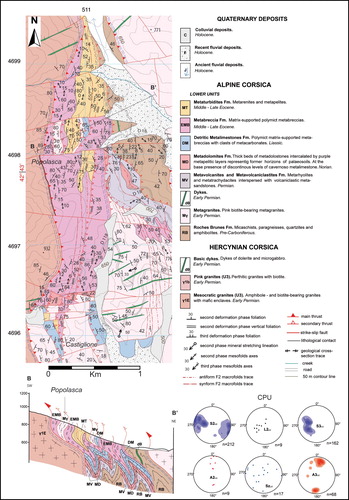
The present steeply dipping setting of the AC units and the relative tectonic contacts is mainly due to late east-verging F3 folds that rotated or overturned them in the early Oligocene (). Subsequently, the relationships among the different units are modified by brittle tectonics connected to the CCSZ, a well-developed system of N-S trending sinistral and ENE-WSW trending dextral faults, associated with m-thick cataclastic zones. Eastward, the relationships among LU, SL and UU and the structures of the CCSZ are not observable, because the contact is sealed by the late Burdigalian to Langhian marine and continental deposits of the Francardo Basin (CitationAlessandri et al., 1977). The latest structures detected in the study area are represented by E-W trending, transtensional faults that dissect both the AC units and the deposits of Francardo basin.
Figure 4. View of the contact between the HC and AC along the Golo Valley. The contact is represented by a deformed, steep surface that upward becomes overturned. Legend: y1b: Pink granites (U3 suite); y3b: monzogranites (U2 suite); RB: Roches Brune Fm.; MV: Metavolcanites and Metavolcaniclastites Fm.
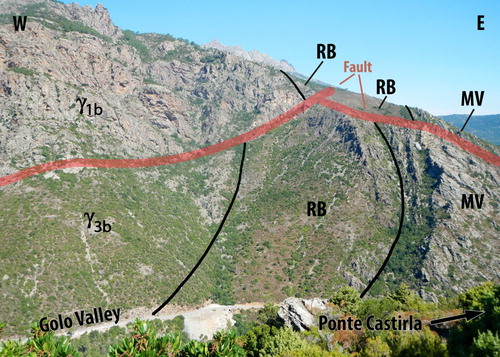
3.1. Hercynian Corsica: overall features
The HC is mainly represented by a basement consisting of the Popolasca Complex, a composite alkaline intrusive suite of Early Permian age (suite U3; 290-280 Ma; CitationRossi et al., 2015). This suite includes, from bottom to top, amphibole-biotite granites characterized by amphibole-rich microgranular enclaves, amphibole-biotite-bearing granites with perthitic texture and pink biotite-bearing granites with perthitic texture. In the southern part of the study area, the Popolasca Complex is intruded into leucocratic biotite-bearing monzogranites belonging to the calc-alkaline suite of Late Carboniferous-Early Permian age (suite U2; 308-275 Ma; CitationRossi et al., 2015). Both suites of granites are cut by a NE-SW to NNE-SSW trending alkaline dyke swarm of Early Permian age. These 0.5–2 m thick dykes are mainly basic in composition and consist of dolerites and microgabbros. The Mesozoic-Cenozoic sedimentary cover does not crop out in the study area. The HC escaped pervasive Alpine deformation but, as also observed in the nearby areas (CitationDi Rosa et al., 2019b; CitationDi Vincenzo et al., 2016), some NNE-SSW trending ductile shear zones occur. These shear zones induced the progressive transformation of granites into foliated protomylonites and mylonites.
3.2. The units of Alpine Corsica: meso- and microscale features
3.2.1. Lower Units
Most of the area is characterized by the outcrops of the LU, i.e. CPU, CAU and PPU. According to CitationDi Rosa et al. (2017b), these units derived from the same paleogeographic domain of the European margin. This domain was characterized by a pre-Carboniferous basement intruded by Late Carboniferous-Early Permian granites that were unconformably overlain by Permian metavolcanites and by two metasedimentary successions of Mesozoic and Cenozoic age, each bounded by angular unconformities. The LU differs among each others mainly for the stratigraphy of the Mesozoic succession, showing differences in thickness and stratigraphy. In addition, deformation and the metamorphic imprint are stronger in the CPU than in the CAU and PPU (CitationDi Rosa et al., 2017b).
The PPU shows the most complete stratigraphic log in the study area. This unit includes a basement consisting of Metagranites ((a)) intruded in an assemblage of polymetamorphic rocks (micaschists, amphibolites, paragneisses and quartzites) known as the Roches Brunes Fm. (CitationTermier & Maury, 1928). This basement is unconformably covered by a thick package of Permian Metavolcanites and Metavolcaniclastites Fm. ((b)) showing a transition to a Mesozoic succession starting with the Norian Metadolomites Fm., which consists of thick beds of gray dolomitic marbles interlayered with levels of red metapelites interpreted as paleosoils. At the base of this formation discontinuous and thin levels of Cavernoso Metalimestones also occur. The Metadolomites Fm. shows a transition to the Hettangian-Sinemurian Metalimestones and Metadolomites Fm., represented by an alternation of thin to thick layer of gray marbles and light-gray metadolomites. The Mesozoic succession ends with the Lower Jurassic Detritic Metalimestones Fm., consisting of a matrix-supported polymict metasandstones and metabreccias ((c)), often characterized by well-graded beds. The Mesozoic succession as well as the basement are unconformably covered by the Metabreccia Fm. Although devoid of fossils, a Cenozoic age is proposed for this metabreccias because the coexistence of carbonate clasts with metamorphic and magmatic ones, as detected in the metabreccia in the CPU, allows a correlation with the PPU (e.g. CitationDi Rosa et al., 2017a).
Figure 5. Lithology from LU: (a) Metagranites (CAU); (b) metavolcaniclastic deposits from Metavolcanites and Metavolcaniclastites Fm. (CPU); (c) detritic metalimestone from Detritic Metalimestones Fm. (PPU); (d) metasandstone from Metasandstones Fm. (CPU).

The CAU is on the other hand characterized by the wide occurrence of Metagranites similar to the HC pink biotite-bearing granites with perthitic texture of Early Permian age. Similarly to the HC granites, the Metagranites are cut by a dike swarm showing an E-W to ENE-WSW trend. The Metagranites are intruded into the Roches Brunes Fm. and are unconformably covered by discontinuous outcrops of Permian Metavolcanites and Metavolcaniclastites Fm., Lower Jurassic Detritic Metalimestones Fm. and middle-late Eocene Metabreccia Fm. (Cf. Aiale Breccia; CitationRossi et al., 1994), both showing the same features detected in the PPU.
The CPU () is the most deformed continental unit of the study area and includes a basement analogous to that of the PPU, unconformably covered by the Permian Metavolcanites and Metavolcaniclastites Fm. and the Norian Metadolomites Fm. In addition, the CPU incorporates several bodies of marble cropping out around the villages of Popolasca and Castiglione, whose protolith is probably represented by the Lower Jurassic Detritic Metalimestones Fm. The basement and the Mesozoic rocks are unconformably covered by a thick sequence of metasedimentary deposits including the Metabreccia Fm. and the Metasandstones Fm. ((d)) of middle to late Eocene age (CitationBezert & Caby, 1988). The Metabreccia Fm. is represented by subrounded to subangular clasts of orthogneisses, paragneisses, micaschists, quartzites, metalimestone and metagranites enclosed in a fine-grain matrix. Near Ponte Ancino, macroforams (see also CitationBezert & Caby, 1988) of Bartonian age (Nummulites biarritzensis, Discocyclina sp., CitationBlondeau, 1972) are included as bioclasts in the carbonate clasts or in the matrix. The deformation in Ponte Ancino are less pervasive compared to the ones in the Popolasca area (see also CitationDi Rosa et al., 2017b) and probably the carbonate clasts suffered lower recrystallization and deformation respect to the surrounding schistose matrix. The Metasandstones Fm. consists of well-bedded, medium layers of metapelites and siliciclastic metarenites ((d), (a) and (c)).
In all the LU an analogous polyphase deformation history was identified and developed in each unit under different P and T conditions. This deformation history includes three phases (D1lu, D2lu, D3lu; CitationBezert & Caby, 1988; CitationDi Rosa et al., 2017a, Citation2017b; CitationDi Rosa et al., 2019a; CitationGarfagnoli et al., 2009; CitationMalasoma et al., 2006; CitationMalasoma & Marroni, 2007).
At the mesoscale, the D1lu phase is generally obliterated by the subsequent deformations. Rare, generally rootless, isoclinal F1lu folds with acute to sub-acute hinges are observed only in the metavolcaniclastites and metasandstones of the CPU. The S1lu foliation can be rarely observed at the microscopic scale in the metapelites ((a)). In fact, the S1lu foliation is preserved only inside microlithons along the S2lu foliation, where it can be described as continuous schistosity characterized by sin-kinematic recrystallization of Chl + Phg + Qtz + Cal (mineral abbreviations after CitationKretz, 1983; Phg: white mica).
Figure 6. Micro-scale deformations in LU: (a) S1lu/S2lu relationships in metarenite from Metasandstones Fm. (CPU); (b) S2lu foliation in metarhyolite from Metavolcanites and Metavolcaniclastites Fm. (CAU); (c) D2lu phase shear zone in Metagranites (CPU); (d) S2lu/S3lu relationships in metarhyolite from Metavolcanites and Metavolcaniclastites Fm. (PPU).
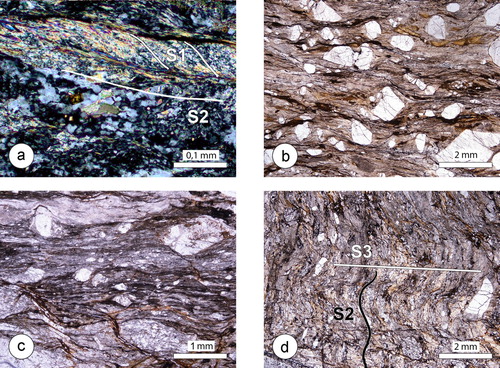
The D2lu phase is the most easily recognizable in the area. In the metasedimentary rocks, it is characterized by the association of F2lu folds ((a)) with the S2lu foliation, that is the most pervasive anisotropy observed in the field. The west-verging sub-isoclinal to isoclinal F2lu folds show rounded hinges and limbs often affected by necking and boudinage. The A2lu axes show an N-S strike in all of the units from the study area. The S2lu foliation shows an N-S trend and bears L2lu mineral and stretching lineation characterized by a strike ranging from NE-SW to E-W and NW-SE. In the metapelites, the L2lu mineral lineation is represented by elongated grains of Chl, Qtz and Phg, whereas in the metalimestones and in the metadolomites the L2lu stretching lineation is represented by boudinaged crystals of Py and Qtz. Metapelites in thin sections show that the S2lu foliation occurs as a zonal- to discrete-type crenulation cleavage, characterized by a new recrystallization of Chl + Phg + Qtz + Ab + Cal ((b)). Unlike the metasediments, the metagranites show a localized deformation with alternation of levels of weakly foliated ((a)) and unfoliated lithotypes.
Figure 7. Meso-scale deformations in LU: (a) F2lu fold in metalimestone from Metalimestones and Metadolomites Fm. (PPU); (b) S2lu foliation deformed by F3lu folds in Metagranites (CPU); (c) F3lu folds in Metabreccia Fm. (PPU); (d) relationships between S2lu and S3lu foliations in metarhyolite from Metavolcanites and Metavolcaniclastites Fm. (CAU).
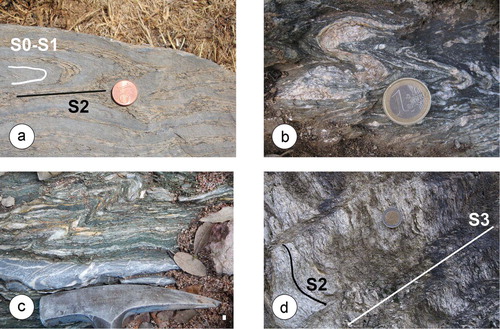
During the late stage of the D2lu phase m-thick, top-to-west shear zones represented by highly deformed rocks developed at the boundaries or inside each unit. In the metasediments, these deformed rock volumes are represented by foliated cataclasites with well-developed S-C structures, whereas the shear zones in metagranites display a penetrative foliation that locally evolved in a true mylonitic foliation ((c)).
The D3lu phase produced east-verging, open to close F3lu folds ((b,c)) with N-S strike axes. The associated flat-lying S3lu foliation ((d)) can be classified as a disjunctive cleavage ((d)) that is rarely recognized in the field. In thin section, recrystallizations of Cal and Qtz were observed only along the S3lu foliation.
The P/T conditions of CPU metamorphism () were estimated on a sample of metapelites from the Metabreccia Fm. collected near the Castiglione village (CitationDi Rosa et al., 2017b, Citation2019a) through the thermodynamic equilibria of Phg-Chl in presence of Qtz and water (CitationDubacq et al., 2010; CitationVidal et al., 2006; CitationVidal & Parra, 2000). The different generations of Chl-Phg development associated with the coeval growth of Ab + Qtz + Cal + KFds along the S1lu and S2lu foliations allowed calculating the P/T conditions of the D1lu and D2lu phases. The conditions of P and T metamorphic peaks were reached during the D1lu phase at 1.10-0.75 GPa/250-330°C and 0.64-0.51 GPa/320-345°C, respectively, followed by a retrograde path constrained by the local equilibrium at 0.45-0.27 GPa/250-310°C registered during the D2lu phase. Similar values are found in another sample of the CPU metasandstones from the Tavignano valley, west of Corte (CitationDi Rosa et al., 2017b). In addition, CitationMolli et al. (2017) estimated P/T conditions of low-grade blueschist facies (temperature T of ca.300°C and P ≥ 0.70 GPa) from the deformation structures observed in a metagranite sample from the study area.
Figure 8. Summary of the pressure-temperature-deformation (P/T-d) paths of the LU in the Central Corsica. P/T-d paths of CPU and PPU are after CitationDi Rosa et al. (2017b) and P/T-d path of CAU after CitationMalasoma et al. (2006). The stacking of the LU occurred during the late D2lu phase.
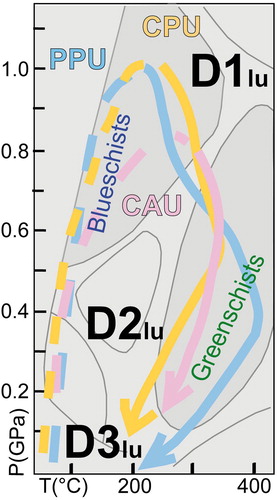
The CAU metamorphic grade was estimated in the metagranites outcropping SW of Prato di Giovellina. According to CitationMalasoma et al. (2006), an assemblage characterized by Na-amp + Phg indicates peak T conditions of 300–370°C and P of 0.50–0.80 GPa ().
In the PPU cropping out in the study area there is not data available, but immediately south of the Golo valley the P/T conditions of the metamorphism were estimated using the same thermo-barometric approach adopted for the CPU (CitationDi Rosa et al., 2017a, Citation2017b). Although data show a similar P/T path to those of CPU, the P and T metamorphic peaks reached by the PPU during the D1lu phase are different, i.e. 1.10-0.75 GPa/200-270°C and 0.80-0.50 GPa/280-400°C, respectively. For the D2lu phase, the P/T conditions in the PPU were calculated as 0.45-0.25 GPa/230-300°C ().
3.2.2. Schistes Lustrés complex
The SL crops out in the south-eastern side of the study area (), immediately east of the Cima Tompio hill to the north of Francardo. Another outcrop of SL is present in the north-east side of the map west of Punta di Tribbio hill. The SL is here represented by the Lento Unit (cf. Inzecca series, CitationCaron et al., 1979) and it is characterized by a strong polyphase deformation characterized by four phases (D1sl, D2 sl, D3 sl, D4sl). The first one (D1sl) is associated to HP metamorphism (CitationLevi et al., 2007). Despite these features, a stratigraphic succession consisting of serpentinites, metagabbros and metabasalts of Middle to Late Jurassic age covered by Lower to Upper Cretaceous calcschists (cf. Erbajolo Fm., CitationRossi et al., 1994) is recognizable.
The fabric elements of the D1sl phase are poorly preserved due to the intense transposition related to the subsequent deformations. Rare, non-cylindrical, intrafoliar F1sl isoclinal folds with acute hinge zones and strongly thinned limbs as well as relicts of an S1sl foliation are observed. At the micro-scale the S1sl foliation can be mainly identified as a relict of a continuous schistosity. In particular, it is represented by the growth of Na-amp + Phg + Qtz + Ab and Phg + Chl + Qtz + Ab + Cal metamorphic mineral assemblages in the metabasites and in the calcschists, respectively. South of the study area, P/T conditions of 0.7-0-5 GPa/265-310°C were calculated for the D1sl (CitationDi Rosa et al., 2020).
However, the most pervasive mesoscale deformation that can be associated to the D2sl phase is characterized by the F2sl isoclinal folds, associated with a well-developed continuous axial-plane S2sl foliation. In thin sections, the S2sl foliation occurs generally as a composite layering defined by overprinting of S2sl foliation on the S1sl one. In the calcschists and in the metabasalts, the S2sl foliation is characterized by the development of Phg + Chl + Qtz + Ab + Cal and Chl + Qtz + Ab + Ep + Ca/Na-Am, respectively. In the calcschists the P/T conditions during the D2sl phase ranges between 0.9-0.7 GPa/240-300°C and 0.6-0.4 GPa/140-275°C (Di Rosa et al., Citation2020).
At the meso-scale the D3sl phase is characterized by the development of close to open F3sl folds showing rounded hinge zones. In the calcschists, the F3sl folds are associated to a discrete-type crenulation cleavage characterized by the growth of Qtz + Cal + Chl + Ill. The subsequent D4sl phase is represented by gentle to open, long-wavelength F4sl folds with sub-horizontal axial planes. The S4sl axial plane foliation corresponds to a weak and very spaced disjunctive cleavage without metamorphic recrystallization.
3.2.3 Upper units
The UU () are represented by the Pineto Unit (cf. Pineto-Tribbio Unit of CitationRossi et al., 1994) consisting of a deformed but weakly metamorphic oceanic succession (CitationDurand-Delga et al., 2005; CitationMarroni & Pandolfi, 2003), that includes a Middle to Late Jurassic ophiolite sequence, represented by gabbros and basalts, covered by Cherts (middle Callovian-Kimmeridgian), Calpionella Limestone Fm. (Tithonian-early Berriasian), San Martino Fm. (early Berrasian-late Hautervian/early Barremian) and Lydienne Flysch (late Hautervian/early Barremian-early Turonian). The Cherts are represented by few meters thick well-bedded radiolarites showing a transition to the Calpionella Limestone Fm.. The latter is characterized by 150 thick alternance of marls and Calpionella-bearing mudstones, often interbedded with coarse-grained mixed-debris strata. The San Martino Fm. consists of few meters of marls, carbonate-free shales and silicified mudstones topped by the Lydienne Flysch (Cf. Balliccione Flysch, CitationDurand-Delga et al., 2005), a 300 m thick succession of thin-bedded, turbidites consisting of beds of sandstones and siltstones interbedded with lenticular coarse-grained breccias strata (CitationBracciali et al., 2007). The UU internal tectonic setting is characterized by a polyphase deformation history that includes three folding phases (from D1uu to D3uu). The D1uu phase is the most penetrative and easily recognized at all the scales by the development of F1uu isoclinal shear folds associated with a continuous S1uu foliation. In the pelites of the San Martino Fm. and of the Lydienne Flysch the S1uu foliation can be classified as slaty cleavage showing a growth of Chl + Ill + Qtz + Cal mineral assemblage which indicates typical very low-grade metamorphism with P/T conditions of 150–200°C and 0.3–0.4 GPa (CitationMarroni & Pandolfi, 2003). The D2uu phase is characterized by westward verging, open to close F2uu folds associated to a crenulation cleavage that developed without sin-kinematic recrystallizations. The later D3uu phase is represented by F3uu folds showing flat-lying axial planes, horizontal fold axes and an eastward vergence.
3.2.4 Miocene deposits of Francardo Basin
The Miocene deposits of the Francardo basin include, from bottom to top, the Ortone, Taverna and Francardo Fms (CitationRossi et al., 1994). The Ortone Fm. consists of 150 m thick levels of poorly sorted and massive conglomerate, formed by pebbles of granites, rhyolites and metamorphic rocks supplied from the HC domains. A level of red conglomerates has been observed at the base of this formation (CitationRossi et al., 1994). These conglomerates represent coalescent mass-flow fans and their age is regarded as late Burdigalian. The Taverna Fm. include a 100 m thick succession of mudstones, sandstones and conglomerates where fossils suggesting brackish to marine environment have been recognized (CitationAlessandri et al., 1977). The relationships with the Ortone Fm. are sharp. The age of the Taverna Fm. is late Burdigalian according to the occurrence of Miogypsina gr. Intermedia. The youngest formation of the Francardo Basin is represented by the Francardo Fm., consisting of 300 m. thick succession of conglomerates and sandstones supplied by the HC domains. This formation, whose age is probably Langhian, is unconformably lying on the Taverna Fm.
3.2.5 Holocene deposits
The Holocene deposits are represented by ancient fluvial deposits with orange paleosoils covered by the recent fluvial deposits with dark paleosoils and then by the colluvial deposits. The latter is represented by angular clasts in a sand matrix. The composition of the clasts strictly reflects the lithology of the substratum.
4. Conclusions
The geological mapping of the area between the Asco and Golo valleys in Central Corsica provided a better understanding of the complex tectonic setting of the AC, formed by a north-south trending stack of tectonic units. This stack is composed, from the structurally lowest to the highest, by three continental metamorphic units belonging to the LU and two oceanic units referred to SL and UU, respectively. The AC units are thrust onto the HC and are unconformably covered by the Lower Miocene deposits of the Francardo Basin. Each unit of the AC is characterized by a different tectono-metamorphic history achieved during the closure of the Ligure-Piemontese oceanic basin and the subsequent continental subduction and collision. After their coupling, the AC units were newly deformed and dissected by the fault system of the CCSZ. This evolution is similar to that recognized in the Ghisoni and Corte area located southward of the Golo Valley, suggesting that a continuous belt of metamorphic and oceanic units crops out along the western border of the AC.
Software
The geological map, the tectonic sketch and the cross-sections were drawn using ESRI ArcGIS 10.0 and Illustrator 3.0. The stereographic projections were plotted with Stereo32.
MDR_MainMap_AR.pdf
Download PDF (61.1 MB)Acknowledgements
The authors thank Luca Barale, Anna D’Atri and John Abraham for their revisions. The project was supported by the University of Pisa (PRA project and ATENEO grant).
Disclosure statement
No potential conflict of interest was reported by the authors.
Additional information
Funding
References
- Alessandri, J. A. , Magné, J. , Pilot, M. D. , & Samuel, E. (1977). Le Miocène de la région de Corte-Francardo. Bulletin de la Société Sciences Historiques et Naturelles de la Corse , 622 , 51–54.
- Bezert, P. , & Caby, R. (1988). Sur l’âge post-bartonien des événements tectono-métamorphiques alpins en bordure orientale de la Corse cristalline (Nord de Corte). Bulletin de la Société Géologique de France , 4 (6), 965–971. doi: 10.2113/gssgfbull.IV.6.965
- Blondeau, A. (1972). Les Nummulites . Vuibert éd. 254 p.
- Bortolotti, V. , Fazzuoli, M. , Pandeli, E. , Principi, G. , Babbini, A. , & Corti, S. (2001). Geology of the central and eastern Elba Island, Italy. Ofioliti , 26 , 97–150. https://doi.org/10.4454/ofioliti.v26i2a.137
- Bracciali, L. , Marroni, M. , Pandolfi, L. , & Rocchi, S. (2007). Geochemistry and petrography of western Tethys Cretaceous sedimentary covers (Corsica and Northern Apennines): from source area to configuration of margins. Geological Society of America Special Paper , 420 , 73–93.
- Caron, J. M. , Delcey, R. , Scius, H. , Essein, J. P. , Fraipont, P. , Mawhin, B. , & Reuber, I. (1979). Répartition cartographique des principaux types des séries dans les Schistes Lustrés de Corse. Comptes Rendus Académie des Sciences Paris , 288 , 1363–1366.
- Di Rosa, M. , De Giorgi, A. , Marroni, M. , & Vidal, O. (2017a). Syn-convergence exhumation of continental crust: Evidence from structural and metamorphic analysis of the Monte Cecu area, Alpine Corsica (Northern Corsica, France). Geological Journal , 52 (6), 919–937. doi: 10.1002/gj.2857
- Di Rosa, M. , De Giorgi, A. , Marroni, M. , & Pandolfi, L. (2017b). Geology of the area between Golo and Tavignano valleys (Central Corsica): a snapshot of the continental metamorphic units of Alpine Corsica. Journal of Maps , 13 (2), 644–653. doi: 10.1080/17445647.2017.1351900
- Di Rosa, M. , Frassi, C. , Meneghini, F. , Marroni, M. , Pandolfi, L. , & De Giorgi, A. (2019a). Tectono-metamorphic evolution of the European continental margin involved in the Alpine subduction: New insights from the Alpine Corsica, France. Comptes Rendus Geoscience , 351 (5), 384–394. doi: 10.1016/j.crte.2018.12.002
- Di Rosa, M. , Frassi, C. , Marroni, M. , Meneghini, F. , & Pandolfi, L. (2019b). Did the “Autochthonous” European foreland of Corsica island (France) experience Alpine subduction? Terra Nova , 32 (1)), 34–43. https://doi.org/10.1111/ter.12433
- Di Rosa, M. , Meneghini, F. , Marroni, M. , Frassi, C. , & Pandolfi, L. (2020). The coupling of high-pressure oceanic and continental units in Alpine Corsica: Evidence for syn-exhumation tectonic erosion at the roof of the plate interface. Lithos , 354–355 , 105328. doi: 10.1016/j.lithos.2019.105328
- Di Vincenzo, G. , Grande, A. , Prosser, G. , Cavazza, W. , & DeCelles, P. G. (2016). 40Ar/39Ar laser dating of ductile shear zones from central Corsica (France): Evidence of Alpine (middle to late Eocene) syn-burial shearing in Variscan granitoids. Lithos , 262 , 369–383. doi: 10.1016/j.lithos.2016.07.022
- Dubacq, B. , Vidal, O. , & De Andrade, V. (2010). Dehydration of dioctahedral aluminous phyllosilicates: Thermodynamic modelling and implications for thermobarometric estimates. Contributions to Mineralogy and Petrology , 159 (2), 159–174. doi: 10.1007/s00410-009-0421-6
- Durand-Delga, M. , Fondecave-Wallez, M. J. , & Rossi, P. (2005). L'unité ophiolitique de Pineto (Corse): signification du détritisme continental dans sa couverture de flysch albo-cénomanien. Comptes Rendus Geoscience , 337 (12), 1084–1095. doi: 10.1016/j.crte.2005.04.004
- Durand-Delga, M. (1984). Principaux traits de la Corse Alpine et correlations avec les Alpes Ligures. Memorie della Società Geologica Italiana , 28 , 285–329.
- Ferrandini, M. , Ferrandini, J. , Loye-Pilot, M. D. , Butterlin, J. , Cravatte, J. , & Janin, M. C. (1998). Le Miocène du bassin de Saint-Florent (Corse): modalités de la transgression du Burdigalien supérieur et mise en évidence du Serravallien. Geobios , 31 (1), 125–137. doi: 10.1016/S0016-6995(98)80102-2
- Garfagnoli, F. , Menna, F. , Pandeli, E. , & Principi, G. (2009). Alpine metamorphic and tectonic evolution of the Inzecca-ghisoni area (southern Alpine Corsica, France). Geological Journal , 44 (2), 191–210. doi: 10.1002/gj.1141
- Gibbons, W. , Waters, C. , & Warburton, J. (1986). The blueschist facies Schistes Lustrés of Alpine Corsica: A review. Geological Society of America Memoire , 164 , 301–331. doi: 10.1130/MEM164-p301
- Kretz, R. (1983). Symbols for rock –forming minerals. American Mineralogist , 68 , 277–279.
- Levi, N. , Malasoma, A. , Marroni, M. , Pandolfi, L. , & Paperini, M. (2007). Tectono- metamorphic history of the ophiolitic Lento unit (northern Corsica): evidences for the complexity of accretion-exhumation processes in a fossil subduction system. Geodinamica Acta , 20 (1–2), 99–118. doi: 10.3166/ga.20.99-118
- Malasoma, M. , Marroni, M. , Musumeci, G. , & Pandolfi, L. (2006). High-pressure mineral assemblage in granitic rocks from continental units, Alpine Corsica, France. Geological Journal , 41 (1), 49–59. doi: 10.1002/gj.1032
- Malasoma, A. , & Marroni, M. (2007). HP-LT metamorphism in the Volparone Breccia (Northern Corsica, France): evidence for involvement of the Europe/Corsica continental margin in the Alpine subduction zone. Journal of Metamorphic Geology , 25 (5), 529–545. doi: 10.1111/j.1525-1314.2007.00712.x
- Malavieille, J. , Chemenda, A. , & Larroque, C. (1998). Evolutionary model for the Alpine Corsica: Mechanism for ophiolite emplacement and exhumation of high-pressure rocks. Terra Nova , 10 (6), 317–322. doi: 10.1046/j.1365-3121.1998.00208.x
- Marroni, M. , & Pandolfi, L. (2003). Deformation history of the ophiolite sequence from the Balagne Nappe, northern Corsica: Insights in the tectonic evolution of the Alpine Corsica. Geological Journal , 38 (1), 67–83. doi: 10.1002/gj.933
- Marroni, M. , Meneghini, F. , & Pandolfi, L. (2017). A revised subduction inception model to explain the late Cretaceous, double vergent orogen in the pre-collisional western Tethys: Evidence from the Northern Apennines. Tectonics , 36 (10), 2227–2249. doi: 10.1002/2017TC004627
- Molli, G. (2008). Northern Apennine-Corsica orogenic system: An updated overview. In S. Siegesmund , B. Fügenschuh , & N. Froitzheim (Eds.), Tectonic Aspects of the Alpine-Dinaride-Carpathian system (pp. 413–442). The Geological Society. Special Publications 298.
- Molli, G. , Menegon, L. , & Malasoma, A. (2017). Switching deformation mode and mechanisms during subduction of continental crust: A case study from Alpine Corsica. Solid Earth , 8 (4), 767–788. doi: 10.5194/se-8-767-2017
- Pandolfi, L. , Marroni, M. , & Malasoma, A. (2016). Stratigraphic and structural features of the Bas Ostriconi Unit (Corsica): paleogeographic implications. Comptes Rendus Geoscience , 348 (8), 630–640. doi: 10.1016/j.crte.2016.07.002
- Ramsay, J. G. (1967). Folding and fracturing of rocks . McGraw-Hill .
- Rossi, P. , Durand-Delga, M. , Caron, J. M. , Guieu, G. , Cconchon, O. , Libourel, G. , & Loye-Pilot, M. D. (1994). Notice explicative de la Feuille Corte 1/50.000. Editions du BRGM, 50 pp.
- Rossi, P. , Cocherie, A. , & Fanning, C. M. (2015). Evidence in Variscan Corsica of a brief and voluminous late Carboniferous to early Permian volcanic-plutonic event contemporaneous with a high-temperature/low-pressure metamorphic peak in the lower crust. Bulletin de la Société Géologique de France , 186 (2-3), 171–192. doi: 10.2113/gssgfbull.186.2-3.171
- Speranza, F. , Villa, I. M. , Sagnotti, L. , Florindo, F. , Cosentino, D. , Cipollari, P. , & Mattei, M. (2002). Age of the Corsica-Sardinia rotation and Liguro-Provençal Basin spreading: New paleomagnetic and Ar/Ar evidence. Tectonophysics , 347 (4), 231–251. doi: 10.1016/S0040-1951(02)00031-8
- Termier, P. , & Maury, E. (1928). Nouvelles observasion géologiques dans la Corse orientale. C. R. Acad. Sci. Paris , 186 , 1077 , 1168, 1247, 1324.
- Vidal, O. , & Parra, T. (2000). Exhumation paths of high pressure metapelites obtained from local equilibria for chlorite-phengite assemblage. Geological Journal , 35 (3–4), 139–161. doi: 10.1002/gj.856
- Vidal, O. , De Andrade, V. , Lewin, E. , Munoz, M. , Parra, T. , & Pascarelli, S. (2006). P–T-deformation-Fe2+/Fe3+mapping at the thin section scale and comparison with XANES mapping: Application to a garnet-bearing metapelite from the Sambagawa metamorphic belt (Japan). Journal of Metamorphic Geology , 24 (7), 669–683. doi: 10.1111/j.1525-1314.2006.00661.x
- Vitale Brovarone, A. , Beyssac, O. , Malavieille, J. , & Molli, G. (2013). Stacking and metamorphism of continuous segments of subducted lithosphere in a high-pressure wedge: The example of Alpine Corsica (France). Earth Sciences Rewiews , 116 , 35–56. doi: 10.1016/j.earscirev.2012.10.003
- Waters, C. N. (1990). The Cenozoic tectonic evolution of Alpine Corsica. Journal of Geological Society of London , 147 (5), 811–824. doi: 10.1144/gsjgs.147.5.0811
